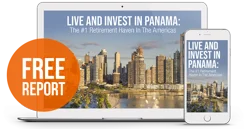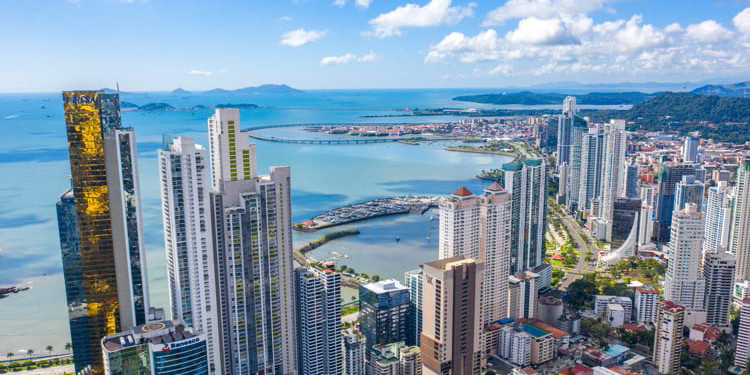Liz Larroquette is one of the most successful real estate executives in Panama, with almost 15 years’ experience in the business.
She’s the right hand of the biggest developer in the country—the one that’s responsible for Panama City’s skyline and its most iconic buildings.
I sat down with her to get an overview of Panama’s property markets, including her insights on the biggest profit-making opportunities today…
Sophia: What’s Panama’s outlook for investors these days? What’s the situation on the ground in its property markets?
Liz: Right now, you can find great deals on foreclosed properties in Panama City, with big chunks of equity in the buy from those units, either through a developer or the bank.
We’re still benefiting from the pandemic in Panama, and the country fared well throughout it because its economy doesn’t rely on tourism the same way Costa Rica’s does, for example.
That said, there are huge infrastructure projects on the horizon that target tourism…
One is the new cruise ship terminal that has capacity for around 7,000 passengers; another is the new conference center with capacity for 20,000 people…
They say that these projects are going to triple tourism within the next couple of years… which would pad out the already robust rental market nicely.
Sophia: Where can real estate investors make money in Panama City today?
Liz: The market is saturated in some areas of Panama City… there’s more inventory than there are renters.
But you can do really well here if you can find a niche market.
One of the niches where I’m seeing super-high occupancy is short-term rentals, because, other than a few exceptions, short-term rentals (of less than 45 days) are illegal in Panama.
You need a special license, and very few residential buildings have obtained this. I’ll be presenting an opportunity at one of those few buildings during Panama’s Hottest Property Deals Spotlight Event today.
Another lucrative niche is smaller units. Most of Panama City’s apartments are designed for families, so they’re big.
Small- to mid-sized apartments of about 1,500 square feet (93 square meters) are harder to find, so there’s massive demand for them, particularly in Costa del Este…
This area is the base for many multinational companies, including big players—Nestlé, Estée Lauder, Procter & Gamble, Huawei, Liberty Media, and more.
These companies are increasing their workforces all the time, and their executives are creating massive demand for smaller units.
Get Your Free Panama Report Today!
Simply enter your email address below and we'll send you our FREE REPORT - Live And Invest In Panama: The #1 Retirement Haven In The Americas.
Sophia: What else will you be revealing to attendees at today’s Spotlight Event?
Liz: We’re definitely going to focus on some niche markets.
We’ve got a real estate investment opportunity that targets those executives but also has provisions for older folks and those looking for “age-in-place” solutions…
The situation with regard to elder care in the United States is insane. There’s a wait list to get into any age-in-place facility, and then once you do get in, you have to pay $5,000 a month to live there.
In comparison, the carrying costs of the age-in-place opportunity I’ll present today are a couple hundred dollars per month… and that’s for luxury-standard accommodation.
You’ll have to register for the event to get the full details of this opportunity.
But you can be sure that I’ll focus on opportunities designed for pure investors and those looking to diversify their portfolio as soon as possible… as well as opportunities with on-site property management, so that they’re totally turn-key.
Sophia: Is Costa del Este the area you’re most excited about in Panama City?
Liz: I’d say that Costa del Este and other areas that have special zoning for multinational companies are where you’re going to see the most opportunity, because the end users tend to be their executives.
The government is incentivizing foreign companies to set up their corporate offices here by creating special tax incentives and labor laws. Plus, being a geographical hub makes Panama the perfect place to set up shop.
Aside from Costa del Este, another zoned area is Panama Pacífico, a huge development on the other side of the Panama Canal. That’s where a lot of logistics-based companies are establishing themselves.
The government is about to build a new bridge over the Canal, so I expect investors to see a huge amount of appreciation around Panama Pacífico as well.
Sophia: What other infrastructure projects are coming Panama City’s way?
Liz: The government is working on the infrastructure for a new Metro line that will go under the Canal.
That, plus the bridge, is going to open the door to the other part of Panama that is currently separated by the Canal.
It will make Playa Bonita, the closest beach to Panama City, much easier to reach.
They’re also developing new roads to Panama City’s main satellite cities, Arraiján and La Chorrera.
The natural continuation of those roads would further open up the coast to the Coronado-Gorgona area, which is the closest expat community to Panama City…
So it may be possible within a few years to park your car at a Metro station and jump on a train to the beach from the city (or to the city from the beach).
Sophia: Sounds like Panama City might be unrecognizable in a few years. It’s been making headlines as a “place to watch” recently…
Liz: Yes, and I think a lot of that has to do with private enterprise. Panama has developed a handful of super-high-end hotels in the past few years.
There is a new Hyatt hotel that opened in the last couple of years called La Compañia; there’s the Sofitel Legend Casco Viejo; Nayara Bocas del Toro on the Caribbean Coast; and Islas Secas on the Pacific Coast.
So now there’s more of a luxury market, and with the power of social media, these high-end properties are able to get a lot of marketing traction.
They’re putting Panama on the map even more than the Panamanian Tourism Authority.
Sophia: Is there anything else people should be aware of if they’re looking to invest in Panama?
Liz: Yes. Right now, you can get permanent residency in Panama by investing a minimum of $300,000 in real estate through its Qualified Investor Permanent Residency program.
The application processing time is quick at only one to two months, and there’s no physical presence requirement to maintain that permanent residency status.
The minimum investment amount is set to increase to $500,000 in October of this year. Part of this depends on Panama’s general elections, coming up on May 5.
I have a flurry of clients who want to get in on that fast-track residency, and if you’re capable of getting on board before October, it’s absolutely worth doing.
With so much uncertainty in the world today, many of my clients here are looking for a Plan B, and residency is a crucial part of any Plan B.
Sincerely,
Sophia Titley
Editor, Overseas Property Alert











